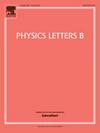广义相对论非微观物质扩展中的粒子及其流体
IF 4.3
2区 物理与天体物理
Q1 ASTRONOMY & ASTROPHYSICS
引用次数: 0
摘要
根据标准的 von Laue 条件,在广义相对论的闵科夫斯基极限中,固定质量和结构的粒子内部的体积平均压力消失。在这里,我们要说明的是,在 f(R,T) 引力或其他引力理论中,线性动量在此极限中不守恒(这里,R 和 T 分别代表利玛窦标量和能量-动量张量的迹线),这个条件一般是不满足的。我们推导出了一个适用于 f(R,T) 引力理论的 R(R)+F(T) 子类的广义 von Laue 条件,并讨论了它的宇宙学意义。我们特别指出,在 R+F(T)引力背景下,宇宙的标准辐射和物质时代演化得以恢复,而与函数 F(T) 的具体属性无关。我们还发现,在这些理论的背景下,尘埃--一种粒子在流体的适当框架内静止的完美流体--一般不能被描述为无压。我们进一步讨论了我们的发现对理想气体壳上拉格朗日形式的影响。本文章由计算机程序翻译,如有差异,请以英文原文为准。
Particles and their fluids in nontrivial matter extensions to general relativity
According to the standard von Laue condition, the volume-averaged pressure inside particles of fixed mass and structure vanishes in the Minkowski limit of general relativity. Here we show that this condition is in general not fulfilled in the context of gravity, or of other theories of gravity in which the linear momentum is not conserved in this limit (here, R and T represent the Ricci scalar and the trace of the energy-momentum tensor, respectively). We derive a generalized von Laue condition valid for the subclass of theories of gravity and discuss its cosmological implications. In particular, we show that the standard radiation and matter era evolution of the universe is recovered in the context gravity independently of the specific properties of the function . We also find that dust — a perfect fluid whose particles are at rest in the fluid's proper frame — cannot in general be described as pressureless in the context of these theories. We further discuss the implications of our findings for the form of the on-shell Lagrangian of an ideal gas.
求助全文
通过发布文献求助,成功后即可免费获取论文全文。
去求助
来源期刊

Physics Letters B
物理-物理:综合
CiteScore
9.10
自引率
6.80%
发文量
647
审稿时长
3 months
期刊介绍:
Physics Letters B ensures the rapid publication of important new results in particle physics, nuclear physics and cosmology. Specialized editors are responsible for contributions in experimental nuclear physics, theoretical nuclear physics, experimental high-energy physics, theoretical high-energy physics, and astrophysics.
 求助内容:
求助内容: 应助结果提醒方式:
应助结果提醒方式:


